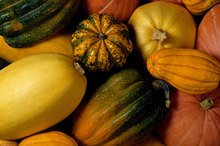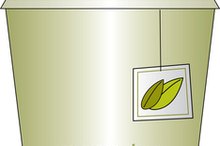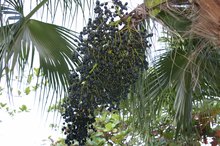What does fact checked mean?
At Healthfully, we strive to deliver objective content that is accurate and up-to-date. Our team periodically reviews articles in order to ensure content quality. The sources cited below consist of evidence from peer-reviewed journals, prominent medical organizations, academic associations, and government data.
- Linus Pauling Institute: Cruciferous Vegetables
- Molecular Nutrition and Food Research: Role of Anthocyanin-Enriched Purple-Fleshed Sweet Potato P40 in Colorectal Cancer Prevention
- Molecular Nutrition and Food Research: Role of Anthocyanin-Enriched Purple-Fleshed Sweet Potato P40 in Colorectal Cancer Prevention
The information contained on this site is for informational purposes only, and should not be used as a substitute for the advice of a professional health care provider. Please check with the appropriate physician regarding health questions and concerns. Although we strive to deliver accurate and up-to-date information, no guarantee to that effect is made.
List of Blue Vegetables
The blue vegetable group is more accurately called the blue-purple or red-purple group because the same phytochemical creates shades or red, blue and purple. Only a few vegetables naturally belong to the blue group, but you can find a variety of specialty vegetables on the market, usually in hues of purple, which were bred to boost beneficial antioxidants.
Significance of Color
All of the vegetables in the blue-purple group contain phytochemicals called anthocyanins. Anthocyanins are pigments responsible for red, blue and purple colors, but they’re also biologically active as antioxidants. Because the blue group includes more fruits than vegetables, much of the research to date is based on anthocyanins extracted from fruit. Laboratory studies cited on the Pennington Biomedical Research Center website show that they may help keep blood vessels healthy, improve vision and inhibit the growth of cancer 2. Anthocyanins are water-soluble, so use a small amount of water when you cook these vegetables to minimize nutrient loss.
- All of the vegetables in the blue-purple group contain phytochemicals called anthocyanins.
- Anthocyanins are pigments responsible for red, blue and purple colors, but they’re also biologically active as antioxidants.
Antioxidant-Rich Eggplant
List of Foods Containing Phytochemicals
Learn More
Purple-skinned varieties of eggplant contain anthocyanins, but only in the skin. To gain the most nutrients, buy smaller-sized eggplants because their skin is more tender and edible than large eggplants. Even if you discard the skin, you’ll still get other antioxidant phytochemicals from the flesh. An abundant phytochemical found in the flesh -- chlorogenic acid -- is one of the most powerful antioxidants produced by plants, according to the U.S. Department of Agriculture 3. When you eat eggplant, you’ll also gain dietary fiber, thiamin and vitamin B-6.
- Purple-skinned varieties of eggplant contain anthocyanins, but only in the skin.
- When you eat eggplant, you’ll also gain dietary fiber, thiamin and vitamin B-6.
Red and Purple Cabbage
You may find varying shades of purple and red in cabbages because the hue changes depending on levels of acidity. Even when it's purple, this type of cabbage is commonly called red cabbage. Red cabbage is a rich source of vitamin A, compared to green cabbage, which has barely a trace of the vitamin. Red varieties also have about 1.5 times more iron and vitamin C than their green counterparts. Purple cabbage contains sulfur-containing substances found only in cruciferous vegetables, which may help prevent some forms of cancer, reports the Linus Pauling Institute 4.
- You may find varying shades of purple and red in cabbages because the hue changes depending on levels of acidity.
- Red cabbage is a rich source of vitamin A, compared to green cabbage, which has barely a trace of the vitamin.
Specialty Vegetables
List of Foods That Contain Nicotine
Learn More
Scientists continue to breed plants to maximize anthocyanin content. Researchers at Oregon State University developed one of the latest varieties, an anthocyanin-rich purple tomato 5. The list of blue-purple vegetables on the website of Rush University Medical Center includes purple asparagus, purple peppers and purple endive 6. You can also find purple carrots, purple cauliflower and purple potatoes. In laboratory studies, anthocyanins from purple sweet potatoes stopped the growth of colorectal cancer cells, according to a study in the November 2013 issue of “Molecular Nutrition and Food Research. 27”
Related Articles
References
- North Dakota State University: What Color Is Your Food?
- Pennington Biomedical Research Center: Pennington Nutrition Series: Anthocyanins
- U.S. Department of Agriculture: Eggplant Found to Have an Antioxidant Kick
- Linus Pauling Institute: Cruciferous Vegetables
- Oregon State University: Purple Tomato Debuts as Indigo Rose
- Rush University Medical Center: Color Guide to Fruits and Vegetables
- Molecular Nutrition and Food Research: Role of Anthocyanin-Enriched Purple-Fleshed Sweet Potato P40 in Colorectal Cancer Prevention
- USDA National Nutrient Database: Eggplant, Cooked, Boiled, Drained, Without Salt
- USDA National Nutrient Database: Cabbage, Red, Raw
- Ball, P. (2001). Bright Earth; Art and the Invention of Colour. Chicago: University of Chicago Press; 2001.
- Morton, J.L. Electromagnetic Color. Color Matters.
Writer Bio
Sandi Busch received a Bachelor of Arts in psychology, then pursued training in nursing and nutrition. She taught families to plan and prepare special diets, worked as a therapeutic support specialist, and now writes about her favorite topics – nutrition, food, families and parenting – for hospitals and trade magazines.









